Effects of activating NK cell receptor expression and NK cell reconstitution on the outcomes of unrelated donor hematopoietic cell transplantation for hematologic malignancies
- PMID: 19212329
- PMCID: PMC2851623
- DOI: 10.1038/leu.2009.21
Effects of activating NK cell receptor expression and NK cell reconstitution on the outcomes of unrelated donor hematopoietic cell transplantation for hematologic malignancies
Abstract
Inhibitory NK cell receptors are recognized as important determinants of NK cell activity in hematopoietic cell transplantation (HCT). The role of activating receptors and their acquisition after HCT is less certain. Therefore, we comprehensively evaluated both inhibitory and activating receptors in 59 patients receiving unrelated donor HCT. NK cell numbers normalized quickly relative to B and T cells; however, the expression of both inhibitory and activating isoforms of killer immunoglobulin-like receptors (KIRs) was delayed. Most NK cells expressed an immature phenotype during the first 6 months post-HCT; however, we found high expression of activating NKp46 and NKp44 natural cytotoxicity receptors (NCRs), and cytotoxicity was preserved. Early reconstituting NK cells from unmanipulated grafts showed lower cytotoxicity than those from T-cell-depleted grafts. Differences in NK cell reconstitution had significant effects on clinical outcomes. Patients whose NK cells reconstituted earlier had better survival and lower relapse rates. The best survival group was recipients who possessed HLA-C2 but their donor lacked the cognate-activating KIR2DS1. Collectively, our data underscore the clinical relevance of reconstituting NK cells and their activating KIRs and NCRs. In addition to NK cell quantification and genotyping, comprehensive assessment of NK cell functions and phenotypes, including activating receptors, is essential.
Figures
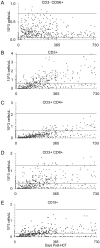
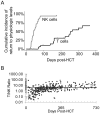
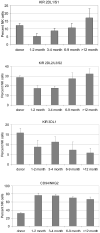
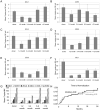
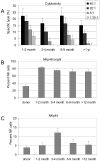
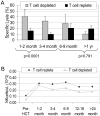

Similar articles
-
Role of Donor Activating KIR-HLA Ligand-Mediated NK Cell Education Status in Control of Malignancy in Hematopoietic Cell Transplant Recipients.Biol Blood Marrow Transplant. 2015 May;21(5):829-39. doi: 10.1016/j.bbmt.2015.01.018. Epub 2015 Jan 21. Biol Blood Marrow Transplant. 2015. PMID: 25617806 Clinical Trial.
-
Improved survival with inhibitory killer immunoglobulin receptor (KIR) gene mismatches and KIR haplotype B donors after nonmyeloablative, HLA-haploidentical bone marrow transplantation.Biol Blood Marrow Transplant. 2010 Apr;16(4):533-42. doi: 10.1016/j.bbmt.2009.11.022. Epub 2009 Dec 2. Biol Blood Marrow Transplant. 2010. PMID: 19961944 Free PMC article. Clinical Trial.
-
KIR reconstitution is altered by T cells in the graft and correlates with clinical outcomes after unrelated donor transplantation.Blood. 2005 Dec 15;106(13):4370-6. doi: 10.1182/blood-2005-04-1644. Epub 2005 Aug 30. Blood. 2005. PMID: 16131567 Free PMC article.
-
Human NK cells: surface receptors, inhibitory checkpoints, and translational applications.Cell Mol Immunol. 2019 May;16(5):430-441. doi: 10.1038/s41423-019-0206-4. Epub 2019 Feb 18. Cell Mol Immunol. 2019. PMID: 30778167 Free PMC article. Review.
-
Natural killer cell receptors: alterations and therapeutic targeting in malignancies.Immunol Res. 2016 Feb;64(1):25-35. doi: 10.1007/s12026-015-8695-4. Immunol Res. 2016. PMID: 26374324 Review.
Cited by
-
NKp46 expression on NK cells as a prognostic and predictive biomarker for response to allo-SCT in patients with AML.Oncoimmunology. 2017 Mar 24;6(12):e1307491. doi: 10.1080/2162402X.2017.1307491. eCollection 2017. Oncoimmunology. 2017. PMID: 29209559 Free PMC article.
-
Peritransplant palifermin use and lymphocyte recovery after T-cell replete, matched related allogeneic hematopoietic cell transplantation.Am J Hematol. 2011 Oct;86(10):879-82. doi: 10.1002/ajh.22136. Am J Hematol. 2011. PMID: 21922528 Free PMC article. Clinical Trial.
-
HLA and KIR genotyping correlates with relapse after T-cell-replete haploidentical transplantation in chronic myeloid leukaemia patients.Br J Cancer. 2014 Sep 9;111(6):1080-8. doi: 10.1038/bjc.2014.423. Epub 2014 Jul 31. Br J Cancer. 2014. PMID: 25077441 Free PMC article.
-
Acute GVHD in patients receiving IL-15/4-1BBL activated NK cells following T-cell-depleted stem cell transplantation.Blood. 2015 Jan 29;125(5):784-92. doi: 10.1182/blood-2014-07-592881. Epub 2014 Dec 1. Blood. 2015. PMID: 25452614 Free PMC article. Clinical Trial.
-
Investigation of KIR/HLA relationship and other clinical variables after T-cell-replete haploidentical bone marrow transplantation in patients with acute myeloid leukemia (AML).BMC Immunol. 2023 Jun 20;24(1):10. doi: 10.1186/s12865-023-00548-1. BMC Immunol. 2023. PMID: 37340345 Free PMC article.
References
-
- Copelan E. Hematopoietic stem-cell transplantation. N Engl J Med. 2006;354:1813–1826. - PubMed
-
- Hongeng S, Krance RA, Bowman LC, Srivastava DK, Cunningham JM, Horwitz EM, et al. Outcomes of transplantation with matched-sibling and unrelated-donor bone marrow in children with leukaemia. Lancet. 1997;350:767–771. - PubMed
-
- Yakoub-Agha I, Mesnil F, Kuentz M, Boiron J, Ifrah N, Milpied N, et al. Allogeneic marrow stem-cell transplantation from human leukocyte antigen-identical siblings versus human leukocyte antigen-allelic-matched unrelated donors (10/10) in patients with standard-risk hematology malignancy: a prospective study from the French society of bone marrow transplantation and cell therapy. J Clin Oncol. 2006;24:5695–5702. - PubMed
-
- National marrow donor program Trends in allogeneic transplants. http://www.marrow.org/PHYSICIAN/URD_Search_and_Tx/Number_of_Allogeneic_T.... Accessed February 6, 2008.
-
- Auletta J, Lazarus H. Immune restoration following hematopoietic stem cell transplantation: an evolving target. Bone Marrow Transplant. 2005;35:835–857. - PubMed
Publication types
MeSH terms
Substances
Grants and funding
LinkOut - more resources
Full Text Sources
Medical
Research Materials
Miscellaneous

